SPM-TH
Scanning Probe Microscopy Theory & Nanomechanics GroupForces and Transport in Nanostructures
Research Activities
Adsorption, reactivity, and self-organization of molecules on surfaces
Organic molecules are an easy an efficient way to modify the properties of metallic surfaces. Deposited as thin films, they are able to transfer their functionalities, selective activity and their ability to respond to environmental changes. Possible technological applications include single-molecule sensors, chiral- selective catalysts, protective coatings, nanofabrication and molecular electronics. Our goals are (1) to understand and control the self-assembly process, exploring the delicate balance between intermolecular and molecular-substrate interactions, and (2) to explore the synthesis of new compounds using the surface as a catalyst.
Influence of the substrate on the properties of physisorbed self-assembled molecular layers
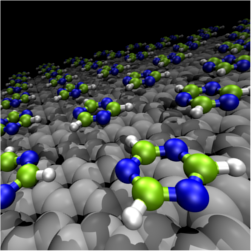 |
We are studying the properties of SAMs formed by the azabenzene1-3-5-Triazine on two similar weak interacting substrates: graphite and graphene on Pt(111). Although the top layer in the substrate isgraphene sheet in both cases, experiments show clear differences in the intermolecular distance, the diffusion energy barriers and the growth mode. We are carrying out DFT calculations with different GGA and hybrid exchange-correlation functionals, and different approaches for the van der Waals interactions (semiempirical, vdW-DFT) to fully characterize the competition between intermolecular (H-bonding and vdW) and molecule-substrate (vdW attraction and Pauli repulsion) interactions. Project members: L. Rodrigo, P. Pou, R. PérezExternal collaboration: A. J. Martínez-Galera, A. Recio, J. M. Gómez-Rodríguez (UAM, Madrid) |
Understanding STM manipulation of the PVBA molecule on the Cu(111) surface
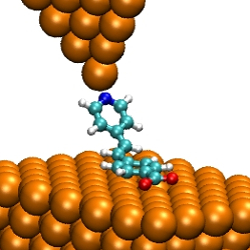 |
STM is a powerful imaging tool additionally capable of surface manipulation. In this study of the PVBA molecule on the Cu(111) surface, we investigate the quantum mechanical phenomena behind the probe- induced molecule displacement, structural modification and deprotonation. Comparison of the computed tunnelling signal with experimental measurements allows us to interpret the experimental data collected during the manipulation and to confirm atomic arrangements at the surface. Through this collaborative approach we aim to establish a toolset for atomic-level control at organic/inorganic interfaces and uncover novel functionalities. Project members: M. Todorovic, R. PérezExternal collaboration: L. Vitali (University of Basque Country/Ikerbasque) and K. Kern (Max Planck Institute for Solid State Research) |
Self-assembling of aminoacids on metal surfaces: Adsorption configuration of Proline on Cu(110)
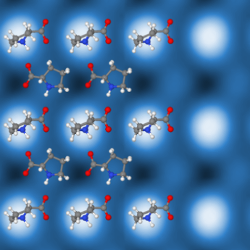 |
The two-dimensional ordered SAMs formed by aminoacids on metal surfaces are highly attractive for technological applications and as models of molecular self-assembly. Our goal is to learn about the hydrogen bonding interactions that control this process through a precise determination of the final adsorption structure resulting from a competition between those intermolecular interactions and the bonds formed by the carboxyl and amino groups with the metal. To that end, we combine a battery of surface science techniques (NEXAFS, LEED, IR absorption and STM) with our theoretical calculations that screen the lowest energy configurations and provide quantitative simulations for the STM images. Project members: L. Rodrigo, G. Biddau (now @ Humboldt University, Berlin), R. PérezExternal collaboration: E. Mateo (Center for Astrobiology-INTA, Spain), J. A. Martín-Gago (ICMM-CSIC, Madrid). |
Vacancy Formation on C60/Pt(111): Unraveling the complex atomistic mechanism
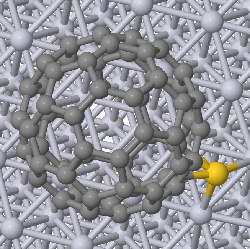 |
The functionalization of metallic surfaces with large organic molecules has become a very relevant topic due its potential applications in catalysis and molecular electronics. Experiments have shown that the C60/Pt(111) system presents a (√13x√13)-R13.9º reconstruction where a Pt vacancy is found below each C60 molecule. In this project, we combine STM and NEXAFS experiments with DFT calculations and STM simulations in order to determine the stable adsorption sites and orientation of C60 on the clean and defective surface, and to unravel the different steps in the mechanism leading to vacancy formation [1]. ref 122 needs to be included in ../publications.html Project members: C. Romero, G. Biddau (now @ Humboldt University), R. Pérez.External collaboration: J. A. Martín Gago (ICMM-CSIC). |
Synthesis of doped Fullerenes by dehydrogenation of planar aromatic precursors
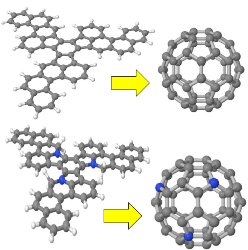 |
Tuning the unique electronic and mechanical properties of fullerenes by selective "doping" will pave the way for nanotechnolgy applications, including molecular electronics and nanomagnetism. However, heterofullerenes and endofullerenes are very difficult to synthesize. In collaboration with organic chemists and surface scientists, we have demonstrated an alternative route for azafullerene synthesis based on planar aromatic precursors and the catalytic role of reactive metallic surfaces in the activation of cyclo- dehydrogenation processes [1]. We have shown that precursors undergo a surface-mediated recognition process, in which just the local surface–molecule interaction induces enantiomeric discrimination [2]. This dehydrogenation can also take place on TiO2(110) surfaces, resulting in the formation of nanodomes [3]. Project members: G. Biddau (now @ Humboldt University), R. Pérez.External collaboration: G. Otero, J. A. Martín Gago (ICMM-CSIC). |